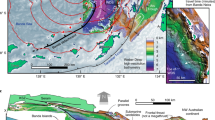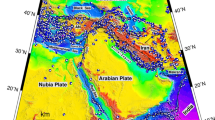Abstract
Recent global space geodetic measurements have revealed that the velocities of tectonic plates over timescales as short as a decade1 are consistent with models of velocities averaged over the past few million years. The slip inferred from interplate thrust earthquakes at deep sea trenches and and number of earthquakes, however, often falls short of that predicted from these observed plate convergence rates2,3. Here we report transient crustal movements recorded by a permanent Global Positioning System (GPS) network in northeastern Japan following a typical interplate earthquake that occurred in December 1994 at the Japan Trench. Cumulative fault slip was estimated from the postseismic displacements at the GPS points over the first year after the event, and the inferred amount of seismic moment released by the afterslip was comparable to that released in the high-speed rupture. Such seismically 'invisible' slip may therefore account for the shortage of seismic slip relative to that required by time-averaged plate velocities.
Similar content being viewed by others
References
Heki, K. Horizontal and vertical crustal movements from three-dimensional very long baseline interferometry kinematic reference frame: implication for the reversal timescale revision. J. Geophys. Res. 101, 3187–3198 (1996).
Pacheco, J. F., Sykes, L. R. & Scholz, C. H. Nature of seismic coupling along simple plate boundaries of the subduction type. J. Geophys. Res. 98, 14133–14159 (1993).
Kawasaki, I. et al. The 1992 Sanriku-Oki, Japan, ultra-slow earthquake. J. Phys. Earth 43, 105–116 (1995).
Sato, T., Imanishi, K. & Kosuga, M. Three-stage rupture process of the 28 December 1994 Sanriku-oki earthquake. Geophys. Res. Lett. 23, 33–36 (1996).
Nishimura, T., Nakahara, H., Sato, H. & Ohtake, M. Source process of the 1994 far east off Sanriku earthquake, Japan, as inferred from a broad-band seismogram. Tohoku Geophys. J. 34, 121–134 (1996).
Tanioka, Y., Ruff, L. & Satake, K. The Sanriku-oki, Japan, earthquake of December 28, 1994 (Mw 7.7): rupture of a different asperity from a previous earthquake. Geophys. Res. Lett. 23, 1465–1468 (1996).
Tsuji, H., Hatanaka, Y., Sagiya, T. & Hashimoto, M. Coseismic crustal deformation from the 1994 Hokkaido-Toho-Oki earthquake monitored by a nationwide continuous GPS array in Japan. Geophys. Res. Lett. 22, 1669–1672 (1995).
Dong, D. & Bock, Y. Global Positioning System network analysis with phase ambiguity resolution applied to crustal deformation studies in California. J. Geophys. Res. 94, 3949–3966 (1989).
Thatcher, W., Matsuda, T., Kato, T. & Rundle, J. B. Lithospheric loading by the 1896 Riku-u earthquake, Northern Japan: implications for plate flexure and asthenospheric rheology. J. Geophys. Res. 85, 6429–6435 (1980).
Bucknam, R. C., Plafker, G. & Sharp, R. V. Fault movement (afterslip) following the Guatemala earthquake of February 4, 1976. Geology 6, 170–173 (1978).
Marone, C. J., Scholtz, C. H. & Bilham, R. On the mechanics of earthquake afterslip. J. Geophys. Res. 96, 8441–8452 (1991).
Okada, Y. Internal deformation due to shear and tensile faults in a half-space. Bull. Seismol. Soc. Am. 82, 1018–1040 (1992).
Sendai District Meteorological Observatory, Japan Meteorological Agency The 1994 Far OffSanriku Earthquake (December 28, M7.5). 75–83 (Rep. 54, Coordinating Committee for Earthq. Pred., Tsukuba-city, Japan, 1995).
Seno, T., Sakurai, T. & Stein, S. Can the Okhotsk plate be discriminated from the North American plate? J. Geophys. Res. 101, 11305–11315 (1996).
DeMets, C., Gordon, R. G., Argus, D. F. & Stein, S. Current plate motions. Geophys. J. Int. 101, 425–478 (1990).
Sheng-Tu, B. & Holts, W. E. Interseismic horizontal deformation in northern Honshu and its relationship with the subduction of the Pacific plate in the Japan trench. Geophys. Res. Lett. 22, 3103–3106 (1996).
Barrientos, S. E. Dual seismogenic behavior: the 1985 Central Chile earthquake. Geophys. Res. Lett. 22, 3541–3544 (1995).
Barrientos, S. E., Plafker, G. & Lorca, E. Postseismic coastal uplift in southern Chile. Geophys. Res. Lett. 19, 701–704 (1992).
Linde, A. T., Gladwin, M. T., Johnston, M. J. S., Gwyther, R. L. & Bilham, R. G. A slow earthquake sequence on the San Andreas fault. Nature 383, 65–68 (1996).
Tanioka, Y. & Satake, K. Fault parameters of the 1896 Sanriku tsunami earthquake estimated from tsunami numerical modeling. Geophys. Res. Lett. 23, 1549–1552 (1996).
Author information
Authors and Affiliations
Rights and permissions
About this article
Cite this article
Heki, K., Miyazaki, S. & Tsuji, H. Silent fault slip following an interplate thrust earthquake at the Japan Trench. Nature 386, 595–598 (1997). https://doi.org/10.1038/386595a0
Received:
Accepted:
Issue Date:
DOI: https://doi.org/10.1038/386595a0
- Springer Nature Limited
This article is cited by
-
A review on slow earthquakes in the Japan Trench
Progress in Earth and Planetary Science (2023)
-
Heterogeneous rheology of Japan subduction zone revealed by postseismic deformation of the 2011 Tohoku-oki earthquake
Progress in Earth and Planetary Science (2023)
-
Postseismic gravity changes after the 2011 Tohoku earthquake observed by superconducting gravimeters at Mizusawa, Japan
Earth, Planets and Space (2023)
-
A machine learning algorithm with random forest for recognizing hidden control factors from seismic fault distribution
Geosciences Journal (2023)
-
Assessment of S-net seafloor pressure data quality in view of seafloor geodesy
Progress in Earth and Planetary Science (2022)





